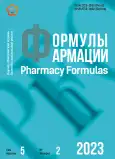Microflora of hatching eggs and ways of its formation
- 作者: Gorfunkel E.P.1, Ilina L.A.1
-
隶属关系:
- BIOTROPH Ltd
- 期: 卷 5, 编号 2 (2023)
- 页面: 65-69
- 栏目: Actual problems: discussion tribune
- URL: https://journals.rcsi.science/PharmForm/article/view/249543
- DOI: https://doi.org/10.17816/phf352544
- ID: 249543
如何引用文章
全文:
详细
In this study, the results were obtained reflecting the content of the genetic material of bacteria in incubation eggs. Given the widespread use of chicken embryos in medicine, veterinary medicine and pharmacology, the identification and identification of microorganisms is an important task. In the course of the study, a quantitative and qualitative analysis of the composition of bacteria in various tissues of incubation eggs was carried out. Three average mixed samples of each typical category were selected: chorion-allantois shell (HAO) on the 8th day of incubation, yolk sacs on the 13th, 18th and 20th days of incubation. The study was conducted using real-time PCR (real-time PCR). The collection of samples and sample preparation were carried out in accordance with established standards, ensuring the reliability and accuracy of the obtained data.
作者简介
Elena Gorfunkel
BIOTROPH Ltd
编辑信件的主要联系方式.
Email: elena@biotrof.ru
SPIN 代码: 2958-6204
Quality Specialist
俄罗斯联邦, Saint Petersburg, PushkinLarisa Ilina
BIOTROPH Ltd
Email: biotrof@biotrof.ru
Doctor of Biological Sciences, Head of the Molecular Genetic Laboratory
俄罗斯联邦, Saint Petersburg, Pushkin参考
- Shmarov M. M., Logunov D. Yu., Cherenova L. V., Picker E. G. Technology for producing recombinant CELO adenoviruses in chicken embryos in preparative quantities // Biomedicine. – 200. – No. 1. – P. 112–113. (In Russ).
- Stroganova I. Ya. Chicken embryos and their use in virology: method. instructions for laboratory classes / I. Ya. Stroganov; Krasnoyarsk State Agrarian University. – Krasnoyarsk, 2013. – 19 p. (In Russ).
- Monstakova T. V., Azarnova T. O., Kochish I. I. Prospects and advantages of using chicken embryos as model systems for pharmaceutical research using the example of cobalt glycine // Veterinary Pharmacological Bulletin. – 2021. – No. 2. – P. 84–91. (In Russ).
- Development of optimal conditions for cultivating the Newcastle disease virus strain in developing chicken embryos / R. Z. Nurgaziev, A. R. Nurgazieva, E. D. Krutskaya [etc.] // Bulletin of NSAU (Novosibirsk State Agrarian University). – 2019. – No. 1(50). – pp. 148–152. – doi: 10.31677/2072-6724-2019-50-1-148-152. (In Russ).
- Knyazeva V. A. Study of the influence of a magnetic field and laser radiation on the development of the musculoskeletal system of a chicken embryo / V. A. Knyazeva, A. G. Shutenkov; scientific hands F. I. Suleymanov // Youth-science and practice of the agro-industrial complex: materials of the 102nd International Scientific and Practical Conference of Students and Postgraduate Students, Vitebsk, May 29–30, 2017 / Vitebsk State Academy of Veterinary Medicine. – Vitebsk: VGAVM, 2017. – Part 1: Veterinary medicine and biological sciences. – P. 179 (In Russ).
- Pyatkina A. A. Limit doses of penicillin, streptomycin and amphotericin-B for SPF chicken embryos, recommended for virological work / A. A. Pyatkina, N. V. Moroz, T. N. Zybina [et al.] // Veterinary pathology. – 2020. – No. 4(74). – P. 5–12. – doi: 10.25690/VETPAT.2020.51.32.005. (In Russ).
- Kade A. Kh. Chicken embryo as an experimental object for studying the development of the cardiovascular system / A. Kh. Kade, A. I. Trofimenko, A. Yu. Turovaya [etc.] // Russian Medical and Biological Bulletin named after Academician I. P. Pavlova. – 2018. – T. 26, No. 4. – P. 538-546. – doi: 10.23888/PAVLOVJ2018264538-546. (In Russ).
- Pyatkina A. A. Limit doses of penicillin, streptomycin and amphotericin-B for SPF chicken embryos, recommended for virological work / A. A. Pyatkina, N. V. Moroz, T. N. Zybina [et al.] // Veterinary pathology. – 2020. – No. 4(74). – P. 5–12. – doi: 10.25690/VETPAT.2020.51.32.005. (In Russ).
补充文件







